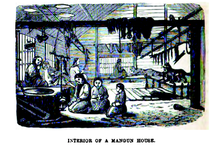- Ulch people
-
Ulchs
Alternative names:
Ulch, Ul'chi, UlchiTotal population 2,913 (est. 2002) Regions with significant populations  Russia: Khabarovsk Krai: Ulchsky District
Russia: Khabarovsk Krai: Ulchsky District Ukraine
Ukraine76 [1] Languages Religion Related ethnic groups History of the Priamurye region
(incl. also Heilongjiang,
Amur Oblast and south. part of Khabarovsk Krai)Sushen Mohe • Shiwei Balhae Khitan Liao Dynasty • Daurs Jin Dynasty (1115–1234) • Nivkh Eastern Jin (1215–1234) Yuan Dynasty • Evenks Yeren Jurchens • Solon Khanate Qing Dynasty • Nanais • Ulchs Russian Exploration • Negidals Manchus-Cossacks wars (1652–1689) Nerchinsk Government-General of Eastern Siberia Aigun Li-Lobanov Treaty Siberian Regional Government Far-Eastern Republic Far-Eastern Oblast Soviet invasion of Manchuria (1945) Sino-Soviet border conflict Far Eastern Federal District
The Ulch (Russian: ульчи, obsolete ольчи; self designation: нани, nani) are an indigenous people of the Russian Far East who speak a Tungusic language, Ulch. Over 90% of Ulchis live in Ulchsky District of Khabarovsk Krai, Russia. According to the 2002 Census, there were 2,913 Ulchs living in Russia — down from 3,173 recorded in the 1989 Census, but up from 2,494 recorded in the 1979 Census, and 2,410 recorded in the 1970 Census.Anthropologically, no clear racial groups exist. Some of them belong to the so-called Sakhalin-Amur group, like the Nivkhs.
References
This article about an ethnic group in Asia is a stub. You can help Wikipedia by expanding it.

